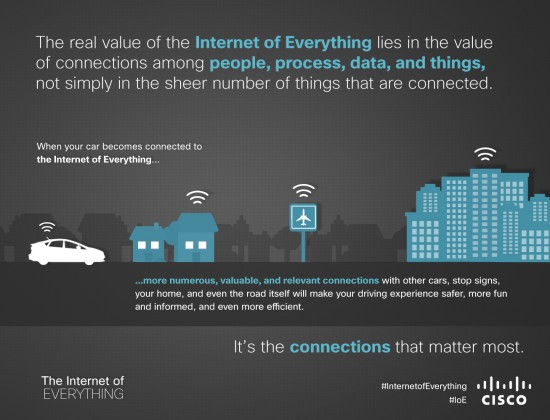































It is important to understand that the real value of the Internet of Everything (IoE) lies in both the number and value of connections.
To illustrate this point, consider the following scenario. When your car becomes connected to the Internet of Everything in the near future, it will simply increase the number of things on the Internet by 1. Now, think about the numerous other elements to which your car could be connected-other cars, stoplights, your home, service personnel, weather reports, warning signs, and even the road itself. It is from these multiple connections that your driving experience will become better than it is today. You will be safer, more informed and entertained, arrive on time, and even save on fuel and maintenance costs as you travel to your destination.
It's the connections that matter most.

With this in mind, Cisco is currently determining the value that comes from a more connected economy. This work revolves around the premise of "value at stake." In a business context, this is the potential value that can be created or will migrate among companies and industries in the emerging "Connections Economy" based on their ability to harness the Internet of Everything over the next decade (by 2023).
In order to measure this value, the team is creating the Cisco Connections Index. The index will quantify the value of connections, which the team defines as "information flows," across five enterprise domains-customer intimacy, employee productivity, supply chain and logistics efficiency, innovation, and asset utilization. When completed, the index will measure the extent and quality of these information flows for companies around the world.
To underscore the importance of connections, I looked at how the number of connections will grow theoretically as more things are added to the Internet. Simply put, the number of connections will dwarf the number of things. Take a look at the chart below. Assuming that there are 10 billion things connected to the Internet today, and that each "thing" connects to only .001% of other things (one in one thousand), the number of theoretical connections is still 499,999,999,950,000.

By 2020, with an Internet that has an estimated 50 billion things, the number of connections balloons to 13,311,666,640,184,600. And adding just one more thing (50 billion + 1) will increase the number of connections by another 50 billion!
While this is just a thought exercise (clearly not every thing will connect to every other thing), even if only a fraction of things connect to other things, the connections among them grow exponentially.
So, while it's fun to play with the numbers, it is clear that the most important aspect of IoE is the value that results from making intelligent and relevant connections to give people and machines the information needed to make better decisions.
In my next blog, I'll describe several examples of the Internet of Everything in action. In the meantime, what are your thoughts? Are connections really more important than the number of things? If so, why? If not, why?
Please,join the conversation:#IoE and#InternetofEverything
 Etiquetas calientes:
Internet of Everything (IOE)
IoE
Dave Evans
Cisco connections index
Etiquetas calientes:
Internet of Everything (IOE)
IoE
Dave Evans
Cisco connections index